Summary for your Investor
- The uptick in Multi-Family Rental supply has created a lot of competition in both primary and secondary markets
- Single-Family Rental supply has been stagnant or decreasing in most markets across the country
- Secondary markets have seen the largest decrease in Single-Family Rental supply, creating a ‘seller’s market’ in those areas if you have a rental to lease
- New Single-Family Rental permits are trending up and new Single-Family supply will follow in 2023 and into 2024
The Single-Family Rental industry has slowed down significantly so far in 2023. Acquisitions are down, buy boxes have shrunk, rent growth is slowing, the two largest public REIT’s in SFR were net sellers in Q1, the list goes on. So if you are in the market to rent a Single-Family home, you likely are not overwhelmed with options right now.
What about Multi-Family? During the pandemic, there was a narrative that everyone was moving away from urban core locations into Single-Family homes in suburbs and corn fields and away from other humans. Did that deter developers from putting more Multi-Family supply on the market? When we look at the data, it appears that new Multi-Family development is as high as it has ever been.
A great way to look at these trends is to track the number of available rentals within each category, so that’s where we will start.
Multi-Family Rentals are increasing, but Single-Family Rentals are not
The PlanOlabs team tracks the number of available rentals across 30 markets for both Single-Family and Multi-Family. What we have found over the last 3 months tells the story clearly.
The chart below shows how the number of available rentals has changed between March 1, 2023, and May 2023. Every market tracked has seen an increase in available Multi-Family Rentals over that time period, while only eight markets saw a double-digit increase in available Single-Family Rentals.
Additionally, the markets with a large decrease in available Single-Family Rentals appear to be mostly secondary markets, such as:
- Birmingham (-12%)
- Oklahoma City (-11%)
- St. Louis (-11%)
- Colorado Springs (-10%)
- Huntsville (-9%)
- Cincinnati (-9%)
- Indianapolis (-6%)
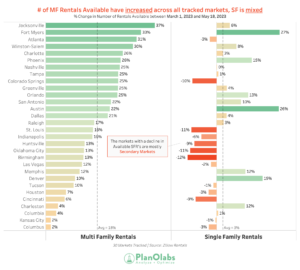
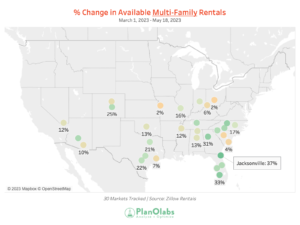
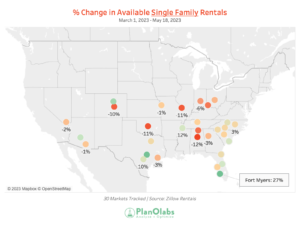
Secondary Market Observation
What we are seeing with the secondary market trend could be attributed to a few possible scenarios:
- Secondary Markets don’t have as much room to push rents as a larger market might. With capital costs where they are right now, it doesn’t make sense to invest heavily in those markets to buy homes and rent them out. The return on investment won’t be nearly as appealing, so investors have not been creating new supply.
- Secondary Markets are highly sought after and any new Single-Family Rental on the market is leased quickly, therefore the number of available Single-Family Rentals has gone down.
Multi-Family Construction
The data shows that Multi-Family construction has been ready to explode over the last couple of years. The chart below shows the number of Authorized Building Permits for Multi-Family last year – look at the 2022 months vs. 2023:
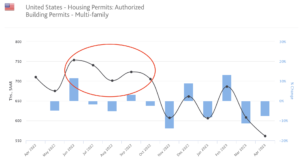
This of course translates directly into active construction which turns into the supply that we analyzed above, and we are seeing historical highs in Units Under Construction for Multi-Family:
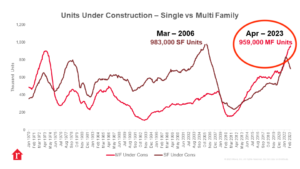
Final Thought
It appears this pendulum will swing back as we continue through 2023 and into 2024. Single-Family permits are now gaining momentum (April 2023 saw the highest rate since September 2022), while Multi-Family permits are slowing (April saw the lowest rate since December 2020).
With vacancy rates ticking up for Multi-Family, and available Multi-Family supply increasing like we saw in the charts above, we expect new Single-Family Rental supply to be the theme and the opportunity over the next 12-18 months.



